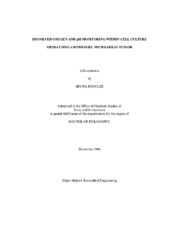| dc.description.abstract | Prolonged exposure of humans and experimental animals to microgravity is
known to be associated with a variety of physiological and cellular disturbances. With
advancements in aerospace technology and prolonged space flights, both organism and
cellular level understanding of the effects of microgravity on cells will become
increasingly important in order to ensure the safety of prolonged space travel. To
understand these effects at the cellular level, on-line sensor technology for the
measurement and control of cell culture processes is required. To do this measurement,
multiple sensors must be implemented to monitor various parameters of the cell culture
medium. The model analytes used in this study were pH and dissolved oxygen which
have physiological importance in a bioreactor environment. In most bioprocesses, pH
and dissolved oxygen need to be monitored and controlled to maintain ionic strength and
avoid hypoxia or hyperoxia. Current techniques used to monitor the value of these
parameters within cell culture media are invasive and cannot be used to make on-line measurements in a closed-loop system. In this research, a microfabricated hydrogel
microarray sensor was developed to monitor each anlyte. Either a pH or an oxygen
sensitive fluorescent agent was immobilized into a hydrogel structure via a soft
lithography technique and the intensity image of the sensor varied from the target
analyte concentration.
A compact detection system was developed to quantify concentration of each
analyte based on the fluorescence image of the sensor. The system included a blue LED
as an illumination source, coupling optics, interference filters and a compact moisture
resistant CCD camera. Various tests were performed for the sensor (sensitivity,
reversibility, and temporal/spatial uniformity) and the detection system (temporal/spatial
stability for the light source and the detector). The detection system and the sensor were
tested with a buffer solution and cell culture media off-line. The standard error of
prediction for oxygen and pH detection was 0.7% and 0.1, respectively, and comparable
to that of commercial probes, well within the range necessary for cell culture monitoring.
Lastly, the system was coupled to a bioreactor and tested over 2 weeks. The sensitivity
and stability of the system was affordable to monitor pH and dissolved oxygen and
shows potential to be used for monitoring those analytes in cell culture media noninvasively. | en |


